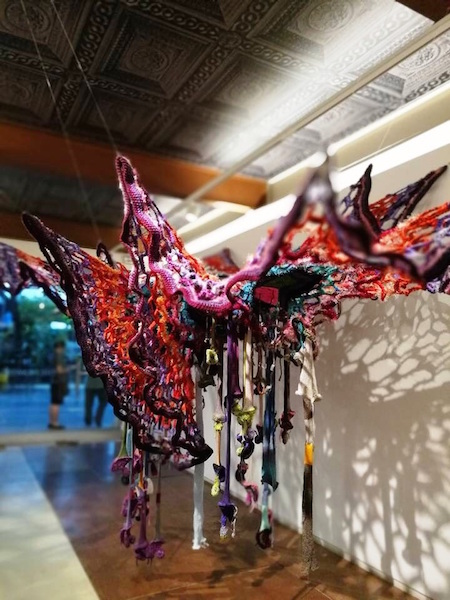
Aze Ong inside one of her sculptures and looking like a caterpillar in a cocoon
A constant in Aze Ong’s past and current yarn art exhibits is the reference to light. To her, light signals experiences and the lessons learned from them.
She said, “Often we don’t know why things happen to us. When we process what had happened, we are naliliwanagan (enlightened). Through openness and acceptance, we learn, we understand more. Maybe I am searching for enlightenment. I know this search will never end because once a question is answered, another pops out. And once all questions are answered, then there will be no reason to wake up the next day. Liwanag (light) keeps me going, keeps me curious and eager to learn.”
Ong’s philosophy is to share her experiences through art. “I don’t follow patterns or sketches. I just pick up yarns scattered on the floor and start crocheting. Eating is my only break. It is hard to sleep knowing that my work isn’t finished yet. During the process, all my thoughts and feelings are put into the artwork as I organically create a form. It is a form of release, it calms me, and it helps me heal. This is my lifetime companion. My purpose is to share this to others.”
For her “Liwanag” exhibit at The Drawing Room, she put up seven pieces: five medium-sized wall pieces, two installations, including a large one she made at her Topaz Arts residency in New York during her Asian Cultural Council fellowship last year. She incorporated small objects collected from her New York experiences like acorns that remind her of trekking and a glove to recall the time she lost its pair in the subway. She continued, “When I look at the sea shells, I remember walking the sands of Coney Island exactly when I needed peace. The works are full of memories, experiences and adventures in New York.

Light in the Cold. (Photo by Ged Merino)
Asked if soft sculpture has a following already in this country, she said, “I’d like to believe it has. However, it really needs a lot of support and acceptance.”
She may be the only one using yarn as her main medium. She said, “The medium is difficult and challenging. There may be artists who incorporate yarn in their work but not in their body of works. There may be artist/s with the same medium of fiber, yarn or thread, but the form is not sculptural or installation.”
Ong noted that yarns are still hard to source in this country, “but there is a significant increase of online sellers of yarns coming from different countries. A lot of people have sent me yarn donations. I am very grateful to them. Most notable is Evelyn Forbes who is so supportive of the medium and has donated sacks and sacks of yarns. Aside from getting rid of their excess yarns, most donations were made to support the medium, to support me to be able to continue what I’m doing. When I receive yarns, I post them on my Facebook wall to thank the donor.”
She also credited the authors ofMusic, Arts, Physical Education, Health (MAPEH) textbooks, saying, “They immensely helped in educating and introducing fiber as medium to students. I would get emails and messages requesting to answer their questions for school projects.”
She considered the “fight” for this medium as “very challenging. Yarn donations boost my morale in pushing further. Anyone who would like to show their support is welcome.”

Liwanag Ko Ngayon. (Photo by Ged Merino)
She acknowledged the support of Drawing Room’s Cesar Villalon in looking brightly at the future of fiber/textile. There are also art critics Patrick Flores and Midori Yamamura who believe in her works. All this gives the Assumption College graduate in media production hope in the future of this medium.
While on her six-month US fellowship, she saw and was inspired by the works of Ruth Asawa who crochets basket wires, Nick Cave’s works and other textile/fiber works by different artists in museums and galleries. She also witnessed crochet street artist Olek during a Pride parade. Ong attended Sheila Pepe’s talk at Parsons School of Fine Arts. This lady’s crocheted works are ephemeral and feminist.
Ong also makes it a habit to don her wearable art and dance inside or in front of important institutions. Asked how American bystanders reacted to her performance art, she replied,
“New York is full of performers from the subway to the parks to the streets. The energies led me to perform in the streets. I burned my feet at the Metropolitan Museum of Art performing barefoot in the summer.”

Tanglaw sa Paglaya. Photo by Camille Calano)
She continued, “The idea is performing only in a New York minute. The performance only takes one minute or less. When people start to watch and my performance ends, they would ask: ‘That’s it? Is there more?’ I have always wanted to go to MOMA so I performed outside. There was a policeman so I asked permission. He explained that so long as you are in the public street, it’s okay. After the performance he told me you should perform more—people are watching and loving it! Performing in the streets freed me from any fear and gained me a lot of confidence.”
She leans towards the colors purple and brown, explaining, “Purple is still my favorite color. I still use it. Brown is my monochromatic go-to color. But lately I have been using a lot of yellows, oranges and reds, probably because of seeing the different stages of the colors of Fall.”
“Liwanag” is on view until May 8 at The Drawing Room Contemporary Art on the groundfloor of Building C, Karrivin Plaza, 2316 Chino Roces avenue extension, Makati City.
